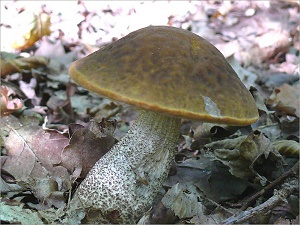| Leccinum pseudoscabrum (Kallenb.) Šutara |
|
|
|
|
|
|
The cap is of variable colours: straw, reddish-brown, pale-brown to dark-brown. The colour also varies according to weather conditions: darker in damp weather, paler in dry weather., fleshy, very firm and hemispherical at first, then spongy, convex to flattened. It is often bumpy or battered, as if deformed by hail or finger pressure. The cap surface is rough and not downy, hardly peelable, moist to slightly slimy, cracked in dry weather and often wrinkled, with depressions like finger or hail marks. The cap margin is exceeding, overhanging the tubes then receding. The stem is full, long and firm-tough, rough because of the small scales arranged in parallel rows at the top, interleaved at the bottom. It is cylindrical or tapering at the apex, rooting and often curved at the bottom. The colour of the stem's background colour is white to grey, the scales on the stem are whitish or yellowish, quickly blackening (also when touched). The scales are darker towards the bottom, and brighter towards the top.. The flesh is thick, very soft, the stem being fibrous. It is white, pinkening when in contact with air for about one minute (without going through an intermediate blue shade), then blackening in the cap, but turning however blue-green in the stem base; its taste is faint or mild; the odour is weak, pleasant; The tubes are adnate or almost free, round close to stem, soft when mature, thin, long (12-27mm). They are whitish, turning yellow then stained with vinaceous red, and eventually greyish; they turn vinaceous red to black when cut and exposed to air. The pores are small, round or sometimes polygonal, white then lemon yellow, turning brown/black when pressed. The spore print is tobacco brown. It grows in broad-leaved woods, in grassy and wet areas, on a rather indifferent soil, essentially with hornbeam and hazelnut (also aspen, white poplar, more rarely with oak, beech and birch). The fruiting period takes place from June to November.
Chemical tests : The flesh becomes : dark green when in contact with iron sulphate, pinkish red when in contact with formaldehyde. Distinctive features : irregular brown cap, with bumps as if struck by hail ; tough stem covered with small black scales; white pores, eventually becoming yellow and grey; flesh in cap turning slowly pink, then eventually black, without transient shades of blue when exposed to air; flesh in stem base turning blue when exposed to air; mostly with hornbeam; Leccinum pseudoscabrum is occasional and widely present in the forest of Rambouillet, and is occasional, more generally speaking . | ||
|
page updated on 14/01/18

